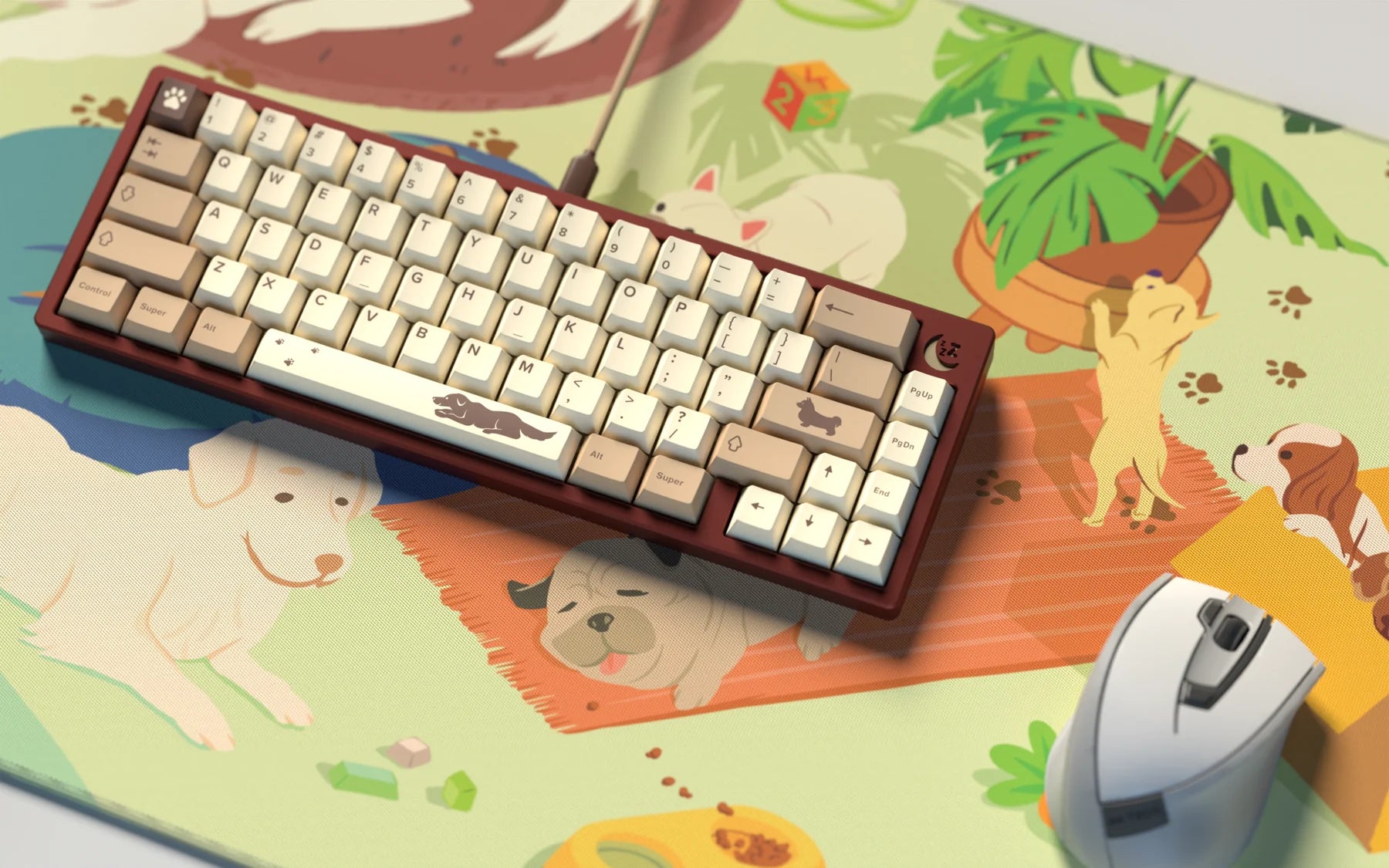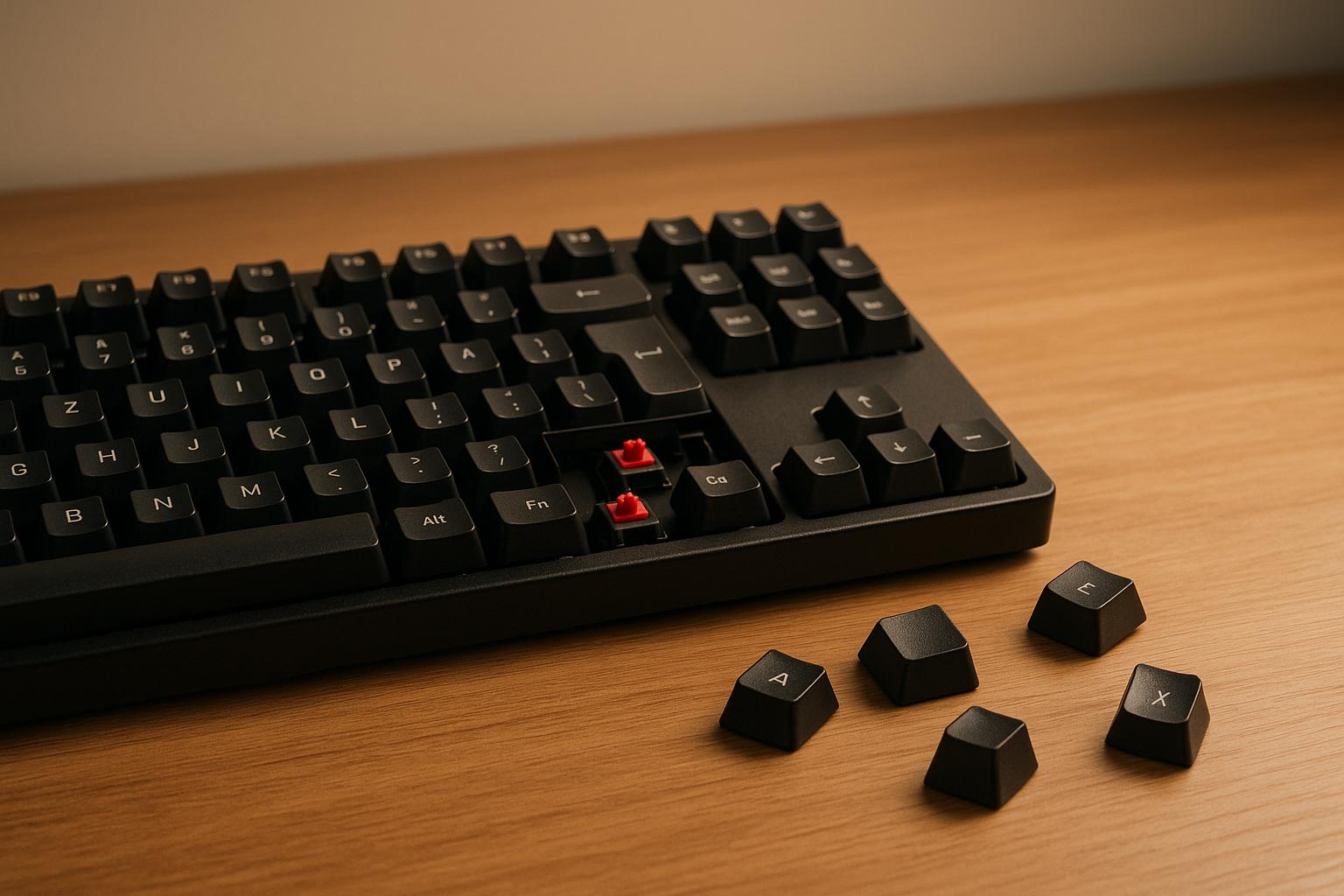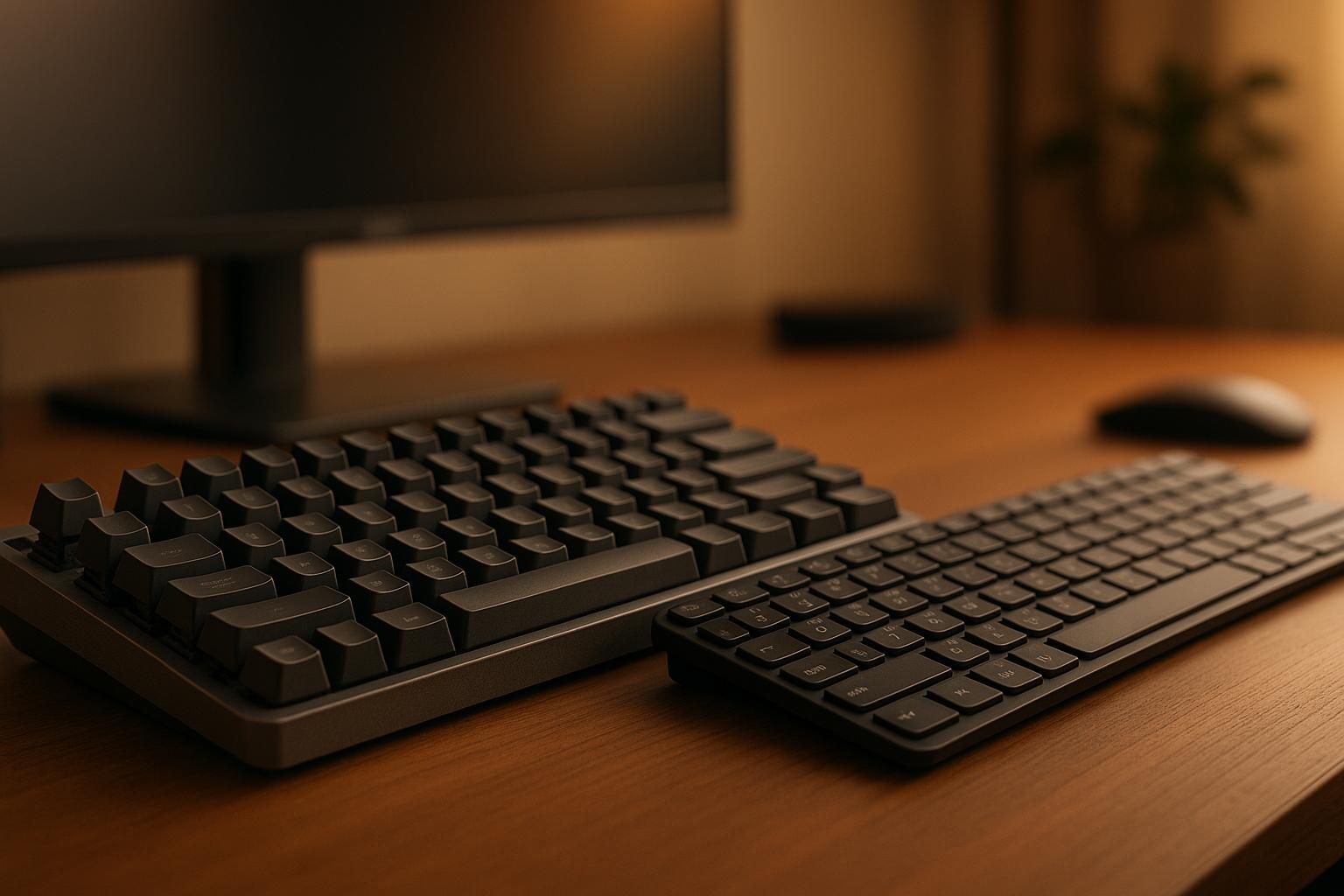Typing for hours? Your keyboard might be hurting you. Research shows that ergonomic keyboards can reduce wrist strain by 68% and improve typing speed by 11%, compared to standard keyboards. Custom mechanical keyboards take this further with features like split layouts, adjustable tilt, and programmable keys. Here's why they matter:
- Comfort: Custom keyboards reduce wrist strain with split designs, wrist rests, and adjustable angles.
- Durability: Mechanical switches last up to 70 million keystrokes, far more than standard keyboards.
- Personalization: Customizable layouts, switches, and keycaps suit your typing style.
- Health Benefits: Lower risk of repetitive strain injuries (RSI) and better posture.
Quick Comparison
| Feature | Standard Keyboards | Custom Keyboards |
|---|---|---|
| Ergonomics | Limited | Adjustable tilt, split layouts |
| Durability | ~5 million keystrokes | ~70 million keystrokes |
| Wrist Support | Fixed, thin | Adjustable, detachable |
| Switch Types | Membrane switches | Mechanical (varied options) |
| Customization | None | Fully customizable |
Custom keyboards are a smart choice for anyone typing long hours, offering better comfort, health benefits, and productivity. Keep reading to learn more about their advantages.
Ergonomic vs Regular Keyboards - Which is Better?
Physical Design Comparison
The physical design of custom keyboards stands out when compared to standard ones, especially in terms of typing comfort and ergonomics. Studies suggest that ergonomic keyboard designs can boost productivity by 10% to 15%. Below, we break down how switch performance, layout innovations, and construction quality contribute to this advantage.
Switch Types and Feel
One of the defining features of custom keyboards is their use of mechanical switches, which provide better tactile feedback and help reduce typing errors. In contrast, standard keyboards often rely on membrane switches, which offer limited feedback. Mechanical switches, with their clear actuation points, are a game-changer for both speed and accuracy. Interestingly, research indicates that linear switches outperform tactile and clicky options for speed and accuracy.
| Switch Type | Tactile Response | Best For | Ergonomic Benefit |
|---|---|---|---|
| Linear | Smooth, consistent | Gaming, quiet environments | Reduced finger fatigue |
| Tactile | Noticeable bump | General typing | Clear keystroke feedback |
| Clicky | Tactile bump with sound | Intensive typing | Enhanced typing accuracy |
Layout Options
Custom keyboards excel in offering layouts designed for natural hand positioning. Unlike the rigid QWERTY layout of standard keyboards - a design dating back to typewriters - custom keyboards introduce innovative designs like split and columnar layouts. Split keyboards allow for shoulder-width hand placement, reducing strain on wrists and shoulders, while columnar layouts align with the natural curve of your fingers for smoother movement.
"A split design lets you align your wrists with your forearms, pushing your elbows slightly outward and your shoulders back, and helping you keep your back straight." – Dygma
Preferences for layouts also vary by region. For example, 75% of European users prefer the ISO layout, while 90% of North American users opt for the ANSI layout. Each layout offers distinct ergonomic perks - ANSI minimizes finger travel, whereas ISO provides easier access to special characters.
Construction Quality
Durability is another area where custom keyboards shine. Most custom mechanical keyboards are built with aluminum cases, giving them a stability that plastic-framed standard keyboards often lack. This stability ensures consistent key positioning, which directly supports ergonomic typing.
The difference in longevity is striking: mechanical switches can handle up to 70 million keystrokes, compared to just 5 million for standard membrane keyboards. This durability ensures that ergonomic benefits, like proper posture and reduced strain, remain intact over time.
Custom keyboards also feature modular designs, allowing users to replace individual components instead of the entire keyboard. This makes it easier to maintain or even improve ergonomic performance over the years, unlike standard keyboards, which typically require full replacement when parts wear out.
Wrist Support Features
Expanding on the ergonomic perks already mentioned, wrist support plays a key role in reducing the risk of repetitive strain injuries (RSI) while enhancing overall typing comfort. Here's a closer look at how custom keyboards stack up against standard ones when it comes to wrist ergonomics.
Wrist Rest Design
Custom keyboards often come with adjustable and detachable wrist rests, designed to help users maintain a neutral wrist position. This is a significant improvement over the fixed and often thinner wrist rests found on standard keyboards.
| Keyboard Type | Height | Adjustable |
|---|---|---|
| Standard | 0.5–0.75 inches | Fixed |
| Custom | 1.0–1.5 inches | Detachable/Adjustable |
"A keyboard wrist rest should never force your wrists into an unnatural position; rather, it should help you maintain a neutral posture, reducing strain and the risk of injury."
Tilt Settings
Custom keyboards shine when it comes to tilt adjustments. They offer precise control, allowing users to independently adjust the front and rear height for optimal alignment. In contrast, standard keyboards typically provide a limited tilt range of 0–6 degrees. Studies suggest that a tilt of 4–8 degrees aligns wrists and forearms effectively, lowering the strain on tendons.
These tilt options often pair well with split keyboard designs, further enhancing wrist alignment and comfort.
Split Keyboard Benefits
Split keyboards are designed to address common issues like ulnar deviation and forearm pronation. By allowing users to place their hands at shoulder-width, these keyboards help reduce wrist strain through customizable positioning.
"Research at the University of Washington has shown that keyboards with the keys curved to match the natural triangle - formed by the left and right hands - improve wrist posture. In addition, the research has shown that wrist rests can also help your hands type in a more relaxed and natural position. Health professionals often prefer ergonomic keyboards since they better match the complex geometry of our bodies and put less strain on our muscles, compared to conventional, rectangular keyboards." - Peter Johnson, PhD, University of Washington
For the best results, consider these adjustments:
| Adjustment Type | Recommended Range | Ergonomic Benefit |
|---|---|---|
| Separation | 6–8 inches | Reduces shoulder tension |
| Tenting Angle | 5–15 degrees | Minimizes forearm rotation |
| Split Angle | 10–30 degrees | Aligns with natural hand position |
It's worth noting that wrist support is most effective when combined with proper positioning and regular breaks during extended typing sessions.
sbb-itb-3cb9615
Personal Comfort Options
Custom keyboards provide a wealth of personalization options, making it easier to create a setup that aligns perfectly with your comfort and typing needs.
Switch Options
The type of mechanical switch you choose plays a big role in both typing comfort and efficiency. Unlike standard keyboards that come with one switch type, custom keyboards offer a variety of Cherry MX switches, each with distinct features:
| Switch Type | Resistance | Feel | Best For |
|---|---|---|---|
| Cherry MX Red | 45 cN | Linear, smooth | Extended typing, gaming |
| Cherry MX Brown | 55 cN | Tactile, subtle | All-purpose use |
| Cherry MX Blue | 60 cN | Clicky, sharp | Precise typing |
| Cherry MX Silent Red | 45 cN | Linear, quiet | Office environments |
"The weight and feel of a switch can influence your typing greatly." - kool-keys, Top 1% Commenter
Switch selection is just the beginning. Keycap profiles also play a major role in achieving ergonomic comfort.
Keycap Shapes
Keycap profiles determine how your fingers interact with the keyboard, influencing both comfort and typing speed:
| Profile Type | Height | Characteristics | Ergonomic Benefits |
|---|---|---|---|
| SA | 16–17mm | Tall, sculpted | Natural finger positioning |
| OEM | 11–13mm | Medium height | Balanced comfort |
| Cherry | 10–11mm | Medium-low | Reduced finger travel |
| XDA | 9–10mm | Uniform, low | Minimal hand movement |
Sculpted profiles like SA and OEM help guide your fingers into natural positions, while uniform profiles such as XDA are ideal for users who value consistent key heights for faster typing.
Custom Key Functions
Another standout feature of custom keyboards is the ability to program keys, which enhances efficiency and reduces strain. With programmable keys, you can:
- Assign complex commands to a single key
- Create shortcuts for frequently used tasks
- Remap keys to better suit your typing style
- Program macros for repetitive tasks
By customizing key functions, you can minimize awkward hand movements and save time. For example, assigning commonly used phrases or commands to specific keys can significantly cut down on repetitive typing.
If you're looking for components to refine your setup, KeebsForAll offers a wide selection of mechanical keyboard parts, including various switches, keycap profiles, and programmable options - all aimed at improving your typing comfort.
Health and Work Benefits
Custom keyboards offer a range of health and productivity advantages that standard keyboards simply can't match.
RSI Prevention
Repetitive Strain Injuries (RSIs) affect a staggering 41% of computer users. Custom keyboards are specifically designed to tackle the key risk factors that contribute to these injuries:
| Risk Factor | Standard Keyboard | Custom Keyboard Solution |
|---|---|---|
| Wrist Position | Forces unnatural angles | Adjustable tilt and tenting |
| Key Force | Inconsistent, often too high | Options for lower activation force |
| Hand Position | Fixed width, one-size-fits-all | Adjustable split design |
| Impact Force | High impact from bottoming out | Dampened switches and customizable actuation |
These ergonomic features not only address the physical strain on your hands and wrists but also encourage healthier typing habits.
Better Posture
Custom keyboards, particularly those with split designs, promote a more natural hand and arm position. Here's how they help:
- Shoulder-width hand placement reduces ulnar deviation (the awkward twisting of wrists toward the pinky side).
- Adjustable tenting lowers forearm pronation, keeping your arms in a more neutral position.
- Customizable layouts eliminate excessive reaching, making typing more comfortable and efficient.
"Research at the University of Washington has shown that keyboards with the keys curved to match the natural triangle - formed by the left and right hands - improve wrist posture. In addition, the research has shown that wrist rests can also help your hands type in a more relaxed and natural position. Health professionals often prefer ergonomic keyboards since they better match the complex geometry of our bodies and put less strain on our muscles, compared to conventional, rectangular keyboards."
- Peter Johnson, PhD, University of Washington
Studies suggest that ergonomic designs can lead to a 10% to 15% increase in productivity. Better posture naturally reduces muscle strain, which ties directly into the next point.
Muscle Use
Custom mechanical keyboards go beyond posture improvements by actively reducing muscle fatigue. Their thoughtful designs include:
| Feature | Benefit | Impact on Muscle Use |
|---|---|---|
| Tactile Feedback | Reduces unnecessary force | Less strain on finger muscles |
| Adjustable Height | Encourages neutral wrist position | Decreases forearm tension |
| Split Design | Allows natural arm placement | Eases shoulder muscle stress |
| Programmable Keys | Cuts down repetitive movements | Lowers overall muscle fatigue |
The durability of mechanical switches - rated for up to 50 million keystrokes - ensures that these ergonomic benefits last for years. This combination of longevity and user-focused design makes custom keyboards a smart investment for maintaining musculoskeletal health.
If you're looking to improve your typing ergonomics, KeebsForAll offers a wide range of ergonomic keyboard components designed to support healthier typing and reduce the risk of RSIs.
Conclusion
Research shows that custom mechanical keyboards offer outstanding ergonomic support. With features like split designs and adjustable tenting, these keyboards significantly improve typing comfort and reduce strain.
These ergonomic improvements lead to measurable benefits:
- Increased productivity: Typing efficiency can improve by 10-15%.
- Long-lasting performance: Durable designs ensure ergonomic benefits over time.
- Better wrist and palm support: Thoughtful layouts reduce stress on key pressure points.
By incorporating features such as adjustable tenting, split layouts, and customizable actuation points, custom mechanical keyboards address the ergonomic shortcomings of standard keyboards. These elements work together to create a more natural and comfortable typing experience:
| Feature | Benefit |
|---|---|
| Adjustable Tenting | Reduces strain from forearm pronation |
| Split Design | Lowers the risk of ulnar deviation |
| Customizable Actuation | Eases finger pressure and fatigue |
| Curved Key Layout | Encourages a neutral wrist position |
If you want to experience these benefits for yourself, KeebsForAll offers a wide range of custom mechanical keyboard components. From ergonomic keyboards to wrist rests and fully customizable parts, they provide options tailored to individual preferences and needs.
Studies confirm that ergonomic keyboards align better with the body’s natural posture, significantly reducing muscle strain compared to traditional designs. For anyone serious about typing health and comfort, custom mechanical keyboards are a smarter, healthier choice.
FAQs
How can custom keyboards reduce the risk of repetitive strain injuries (RSI) compared to standard keyboards?
Custom keyboards are a smart way to lower the chances of repetitive strain injuries (RSI) thanks to their ergonomic design options that cater to individual needs. With many custom mechanical keyboards, you can tweak layouts, key placements, and switch types to encourage a more natural typing posture, reducing stress on your wrists and fingers.
Standard keyboards often stick to a flat, rigid design, which isn’t ideal for long-term comfort. In contrast, custom keyboards can feature angled layouts, wrist rests, or split designs that promote better wrist alignment. These modifications help ease muscle tension and repetitive stress, making them a solid choice for those who type for hours on end. Choosing a custom keyboard isn’t just about comfort - it’s a practical step toward protecting your hands and wrists during extended typing sessions.
How do different switch types in custom keyboards improve typing comfort and efficiency?
The choice of switch in a custom keyboard can significantly impact your typing experience, affecting both comfort and efficiency. Custom keyboards typically feature three main switch types: linear, tactile, and clicky.
- Linear switches deliver a smooth, uninterrupted keystroke. These are perfect for fast typists and gamers since they require consistent pressure and operate quietly.
- Tactile switches have a distinct bump at the actuation point, giving you a clear signal when a keypress is registered. This feedback can improve both accuracy and comfort during extended typing sessions.
- Clicky switches combine the tactile bump with an audible click. While many users enjoy the satisfying sound, these switches might not be the best choice for shared or quiet environments due to their noise level.
Ultimately, the best switch for you depends on your personal preferences and typing habits. Custom keyboards let you fine-tune your setup to create a typing experience that feels just right, especially if you’re spending hours at your desk.
How can custom keyboards be tailored to meet ergonomic needs?
Custom keyboards come packed with features that prioritize comfort and ease, especially when it comes to typing ergonomics. For starters, split keyboard designs let you position each half separately. This setup helps keep your wrists in a natural position, reducing strain and discomfort. On top of that, many models offer adjustable angles and heights, so you can tweak the setup to match your posture perfectly.
Another standout feature is the ability to pick key switches that suit your typing style. Some switches require less force to press, which can reduce finger fatigue and make long typing sessions more comfortable. Add to that extras like cushioned palm rests and curved keyframes, and you’ve got a keyboard designed to make typing as easy on your hands as possible. If comfort is high on your list, custom keyboards are worth considering.



![[Pre-Order] Autumn Leaves PBT Keycaps - KeebsForAll](http://keebsforall.com/cdn/shop/products/DSC09732.jpg?v=1676148273)






Leave a comment
This site is protected by hCaptcha and the hCaptcha Privacy Policy and Terms of Service apply.